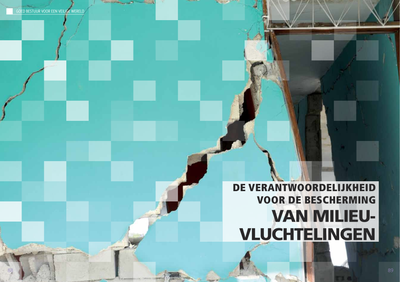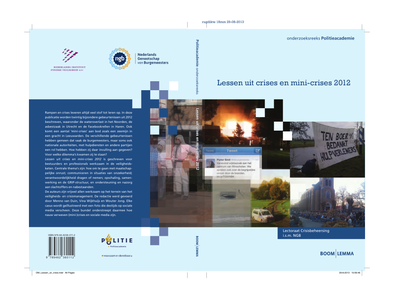In Nederland worden jaarlijks ruim 86.000 ernstig zieke patiënten op een Intensive Care (ic) opgenomen, van wie naar schatting ongeveer 28.000 ic-overlevenden langdurige klachten ondervinden, ook wel samengevat onder de term post-intensive care syndroom (PICS). PICS staat voor het geheel van fysieke, mentale en cognitieve problemen, zoals spierzwakte (ICU-acquired weakness [ICU-AW]), verminderde cardiopulmonale capaciteit, angst, depressie, posttraumatische stressstoornis, concentratie- en geheugenproblemen. De aard van de beperkingen vraagt om interdisciplinaire revalidatie-behandeling, maar tot op heden bestaat hier geen gestructu- reerd revalidatietraject voor en krijgt minder dan de helft van de ic-overlevenden de juiste behandeling na ontslag uit het ziekenhuis.
DOCUMENT
Verslag samengesteld op verzoek van het Ministerie van Volksgezondheid, Welzijn en Sport door drs. Ans Buys (voorzitter ADEF en directeur Fontys Lerarenopleiding Tilburg.
DOCUMENT

Maintaining or increasing physical activity (PA) may prevent loss of muscle mass and strength after completion of head and neck cancer (HNC) treatment. However, the exercise level of HNC patients may not meet PA guidelines. We aimed to explore HNC survivors' views on PA, their report of PA, and to compare these with objectively measured PA. Combined qualitative and quantitative data of HNC survivors were explored post-treatment. Data from semi-structured interviews, questionnaires, and objective measurements of PA were collected, analyzed, and integrated. This resulted in the identification of five themes related to prioritizing, day-to-day life, intention, positive feelings, and social support, respectively, in nine HNC survivors (male: n = 5; age: 52-67 years). Objectively measured PA levels were sedentary to low. The lack of intention to increase PA may be related to HNC survivors' perception that their current activity level is sufficient, despite low levels of measured PA. While some participants feel they need no help with PA, others are insecure about possible harms. Healthcare professionals may be able to help improve PA in HNC survivors with a tailored approach that reduces fear of harm and helps to incorporate higher intensity PA in daily activities.
DOCUMENT
Dit artikel gaat over de waarde van Twitter als een nieuwsbron voor journalisten. Het artikel poogt de theoretische discussie in de literatuur over de mogelijkheden en de waarde van Twitter een empirische grondslag te geven. In die discussie speelt het artikel van Alfred Hermida, 'Twittering the News', een centrale rol. In dit artikel wordt berichtgeving via Twitter rondom de crash van Turkish Airline TK 1951 op 25 februari 2009 op Schiphol tot uitgangspunt genomen. De analyse, gebaseerd op een beoordeling van de tweets op verschillende variabelen, beschrijft de nieuwswaarde van Twitter en laat zien hoe het nieuws via Twitter zich ontwikkelt. Ten tweede wordt een vergelijking gemaakt met de crash van Ryanair in Schotland op 23 december en de crash van American Airlines op 22 december op het vliegveld van Kingston op Jamaica. Deze drie gevallen zijn als ongeval goed vergelijkbaar en op alle drie de gevallen is eenzelfde analyse toegepast, waarbij duidelijk verschillen zijn aan te wijzen in de rol van Twitter als nieuwsbron. Aan het eind van het artikel komt de vraag aan de orde of 'wisdom of the crowds', dat is het filteren van het nieuws door de gebruikers zelf, een rol speelt? Daarvoor wordt een vergelijking gemaakt tussen de tweets rondom de Schiphol crash en de verslaggeving via Coveritlive, waarin ook gebruik werd gemaakt van de input van Twitter en commentaar van de gebruikers, en waarbij een journalist de rol van moderator had.
DOCUMENT

OBJECTIVE: To describe the long-term functioning of patients who survived a COVID-19-related admission to the intensive care unit and their family members, in the physical, social, mental and spiritual domain.DESIGN: A single-centre, prospective cohort study with a mixed-methods design.SETTING: The intensive care unit of the University Medical Center Groningen in the Netherlands.MAIN OUTCOME MEASURES: To study functioning 12 months after intensive care discharge several measurements were used, including a standardised list of physical problems, the Clinical Frailty Scale, the Medical Outcomes Study Short-Form General Health Survey, the McMaster Family Assessment Device, the Hospital Anxiety and Depression Scale, and the Spiritual Needs Questionnaire, as well as open questions and interviews with survivors and their family members.RESULTS: A total of 56 survivors (77%) returned the 12-month questionnaire, whose median age was 62 (inter-quartile range [IQR]: 55.0-68.0). Moreover, 67 family members (66%) returned the 12-month questionnaire, whose median age was 58 (IQR: 43-66). At least one physical problem was reported by 93% of the survivors, with 22% reporting changes in their work-status. Both survivors (84%) and their family members (85%) reported at least one spiritual need. The need to feel connected with family was the strongest. The main theme was 'returning to normal' in the interviews with survivors and 'if the patient is well, I am well' in the interviews with family members.CONCLUSIONS: One year after discharge, both COVID-19 intensive care survivors and their family members positively evaluate their health-status. Survivors experience physical impairments, and their family members' well-being is strongly impacted by the health of the survivor.
DOCUMENT
Er is wereldwijd een groeiende groep milieuvluchtelingen waarvoor nog geen internationaal beschermingsregime bestaat. Het internationaal recht biedt geen adequaat antwoord. Dit artikel laat zien welke soorten milieuvluchtelingen bestaan, en zal betogen dat de bescherming van deze groep plaats kan vinden onder het VN-principe The Responsibility to Protect (R2P). Staten en de internationale gemeenschap hebben een zorgplicht voor milieuvluchtelingen. De basis hiervan ligt bij de Rechten van de Mens. De effectieve uitvoering van een aantal basisrechten wordt immers negatief beïnvloed door milieudegradatie. Tevens wordt staatssoevereiniteit steeds meer beschouwd als een verantwoordelijkheid. Via The Responsibility to Protect ontstaat er een integrale aanpak: 1) een staat is ten eerste zelf verantwoordelijk voor de bescherming van milieuvluchtelingen, 2) de internationale gemeenschap heeft een verantwoordelijkheid een staat hierbij te assisteren, en 3) indien een staat zijn milieuvluchtelingen niet wil of niet kan beschermen, verschuift de verantwoordelijkheid voor dit probleem naar de internationale gemeenschap, om collectief snel en beslissend te reageren. ABSTRACT The number of environmental refugees is growing, but an international legal protection regime is non-existent. This article shows eight different kinds of environmental refugees, and will argue that the protection of these groups can take place under the UN principle The Responsibility to Protect (R2P). States and the international community are obliged to help environmental refugees, based on the International Bill of Human Rights. The effective implementation of basic rights is influenced negatively by environmental degradation. Furthermore, changed notions regarding state sovereignty are also pointing at the responsibility of the state. The Responsibility to Protect (R2P) offers an integral approach: In first instance, the responsibility to take protective measures lies with the state itself. Secondly, the international community has a responsibility to assist. Lastly, when a state is not able or willing to protect its environmental refugees, the responsibility yields to the international community, to respond in a swift and decisive manner.
DOCUMENT

Full text via link.
DOCUMENT

OBJECTIVE: Perceived fatigue significantly impacts quality of life after burns, yet how often it occurs is unknown. Therefor this study assessed the prevalence of perceived fatigue of burn survivors.METHODS: In February 2023, a systematic literature search was performed in CINAHL, Embase, PsycInfo, PubMed and Web of Science. Studies reporting the prevalence of post-burn perceived fatigue were included.RESULTS: In ten cross-sectional studies of moderate-high quality with measurements between 5.3 days and 42 years post burn, the prevalence of perceived fatigue varied between 5 % and 78 % with no apparent time trends. Broad study populations hindered explaining this varying prevalence by age or %TBSA. In four high-quality longitudinal studies with 3-5 measurements between 1 and 24 months post burn, the prevalence decreased over time, dropping from approximately 70 to 50 % in adults and 65 to 28 % in children. Studies used various measurement instruments and cut-off points for operationalizing perceived fatigue, severely limiting the interpretation and comparison of prevalence rates across studies.CONCLUSIONS: The high prevalence and persistent nature of perceived fatigue among burn survivors emphasize its crucial role in burn rehabilitation. Future studies should prioritize identifying individuals with adverse trajectories of perceived fatigue and unravelling underlying mechanisms to develop effective treatments for reducing post-burn perceived fatigue.
DOCUMENT
Hoofdstuk 18 in 'Lessen uit crises en mini-crises 2012' van Duin, van M., Wijkhuijs, V. en Jong, W. (red.) (p. 255-268). Op 3 december 2012 overlijdt Richard Nieuwenhuizen, grensrechter bij de Almeerse voetbalvereniging Buitenboys, nadat hij een dag eerder na een wedstrijd was toegetakeld door spelers van het bezoekende voetbalteam. De dagen na het incident is er veel aandacht voor de gebeurtenis in Almere. Hoewel daarbij geen sprake is van een bestuurlijk dilemma, is het interessant te bezien hoeveel verschillende invalshoeken in de media te berde werden gebracht. Al deze verschillende invalshoeken zeggen niet alleen iets over de aandacht voor, en de impact van de gebeurtenis, maar ook iets over de gebeurtenis zelf. Kennelijk is het een gebeurtenis die – zoals dat vaker met echte crises het geval is – relaties heeft met of (al dan niet terecht) gekoppeld wordt aan verschillende beleidsterreinen en thema’s. Door vertegenwoordigers van een groot aantal organisaties en instanties zijn uiteenlopende meningen en standpunten geventileerd, die steeds weer een andere kijk op de gebeurtenis geven en die relaties leggen met verschillende maatschappelijke problemen. Anders geformuleerd, er kan ook gesteld worden dat de dood van de grensrechter bij uitstek voor velen het momentum bood om datgene te zeggen wat men al langer wilde zeggen of soms al tientallen keren had gezegd. De gebeurtenis bood mogelijkheden: de crisis gaf kansen om bepaalde gedachten te expliciteren en ventileren. In tegenstelling tot de meeste andere hoofdstukken is in het kader van dit hoofdstuk niet gesproken met betrokkenen (bijvoorbeeld de burgemeester van Almere). Het hoofdstuk geeft een ‘tour de horizon’ van datgene wat de eerste paar weken allemaal over deze casus in met name kranten te berde werd gebracht
DOCUMENT
